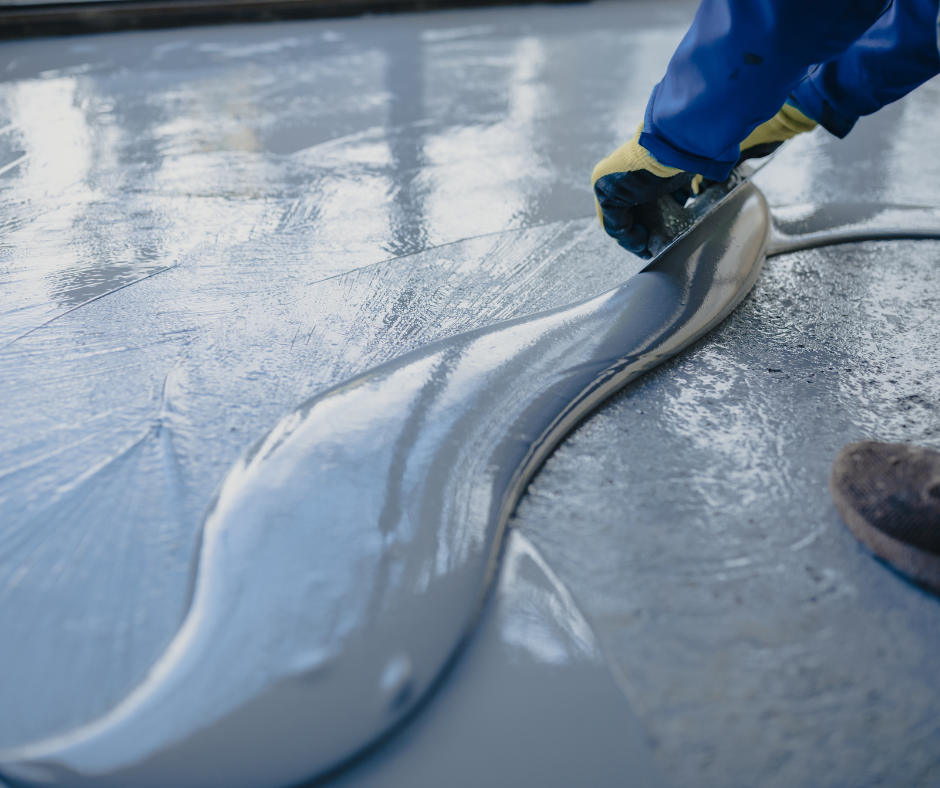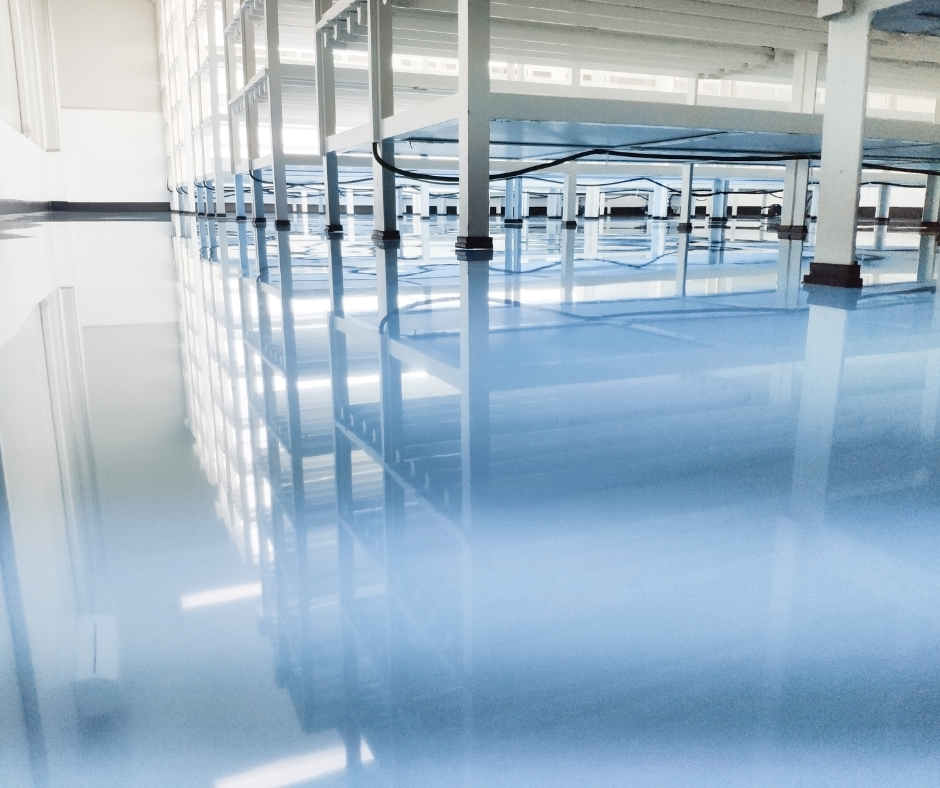Epoxy flooring has become a popular choice for both residential and industrial applications due to its durability, cost-effectiveness, and aesthetic appeal. Whether you’re looking to upgrade your garage floors or enhance the look of your commercial space, understanding the ins and outs of epoxy floor coatings can help you achieve the best results. On the other hand, we highly recommend looking into epoxy alternatives that have even more strength and durability, such as polyurea. In this comprehensive guide, we’ll delve into everything from epoxy resin basics to installation tips, ensuring you have all the information needed for your next flooring project.
What is Epoxy Flooring?
Epoxy flooring is a type of floor coating made from epoxy resin, a thermosetting polymer that creates a hard, durable surface when mixed with a hardener. Epoxy floor kits are available for those looking to undertake DIY projects. This coating system is renowned for its excellent adhesion, chemical resistance, and long-lasting performance. It’s commonly used in garages, warehouses, and industrial floors but is also gaining popularity in residential spaces for its sleek, modern look.
Benefits of Epoxy Floor Coatings
- Durability: Epoxy floors are quite durable, making them ideal for medium-traffic areas and environments. However, polyaspartic flooring is even more durable, so it may be a better fit for your environment.
- Chemical Resistance: One of the standout features of epoxy floor coatings is their resistance to harsh chemicals. This makes them perfect for environments where chemical spills are common, such as laboratories, manufacturing plants, and garages.
- Low Odor and VOC Content: Modern epoxy resins are designed to emit low odors and have low VOC (volatile organic compound) content, making them safer for indoor use and environmentally friendly.
- Aesthetic Appeal: Epoxy floors are available in a wide range of colors, finishes, and styles, including glitter and metallic effects. This allows you to create a customized look that matches your space perfectly.
- Cost-Effective: Compared to other flooring options, epoxy flooring is relatively inexpensive, especially considering its durability and longevity. It’s a one-time investment that can save you money on maintenance and replacement costs.
- Easy Maintenance: Epoxy floors are easy to clean and maintain. Their seamless, non-porous surface resists bacteria and moisture, making them ideal for environments that require high hygiene standards.
- Comprehensive Solution: Using an epoxy floor kit offers a convenient and comprehensive solution for achieving professional-quality results. These kits are designed to be strong and long-lasting, suitable for commercial kitchens, industrial warehouses, and busy garages. They provide a clear, tough coating that is resistant to chemicals and ensures stunning epoxy floors.

Types of Epoxy Floor Coatings
- Self-Leveling Epoxy: This type of epoxy coating is ideal for new and old concrete floors. It creates a smooth, level surface and is perfect for kitchens, dining rooms, storage places, garages, and warehouses.
- Epoxy Mortar Floors: Known for their durability, epoxy mortar floors are made of 100% solid epoxies and graded or quartz sand. They are perfect for areas that require a floor that’s highly resistant to heavy impact.
- Quartz-Filled Epoxy Floors: These are highly decorative and durable. They are made of a combination of epoxy polymer resin and stained quartz grains. Ideal for restrooms, lobbies, schools, and offices.
- Anti-Static Epoxy Floors: These coatings are essential in environments where static-sensitive equipment is in use. They help to reduce static hazards, making them ideal for electronics manufacturing plants, labs, and hospitals.
- Epoxy Flake Floors: This type incorporates colored flake materials in the epoxy, providing a vibrant and attractive look. They are perfect for garage floors, sports venues, and other spaces requiring a decorative touch.
Epoxy floor kits are available for each type of coating, making it easier for users to select the right kit for their specific needs.
Surface Preparation for Epoxy Flooring
Proper surface preparation is crucial for a successful epoxy floor coating application. The surface must be clean, dry, and free of any contaminants such as oil, grease, or dust. Epoxy floor kits often include all the necessary materials for proper surface preparation. Here are the steps for surface preparation:
- Cleaning: Use a degreaser or a suitable cleaning solution to remove any oil or grease. A thorough cleaning ensures proper adhesion of the epoxy coating.
- Repairing Cracks and Holes: Fill any cracks or holes in the concrete surface with an appropriate filler. This helps to create a smooth and even surface for the epoxy application.
- Etching: Use an acid etching solution or a mechanical grinder to open up the concrete surface. This step increases the surface’s porosity, enhancing the epoxy’s adhesion.
- Priming: Apply a primer coat to the prepared surface. The primer helps to seal the concrete and provides a better bonding surface for the epoxy top coat.
- Drying: Allow the surface to dry completely before applying the epoxy coating. Any moisture can prevent the epoxy from adhering properly.
Applying Epoxy Floor Coatings
Applying epoxy floor coatings involves mixing the resin and hardener, applying the mixture to the floor, and allowing it to cure. Epoxy floor kits simplify the application process by providing pre-measured components and detailed instructions. Here are the steps involved:
- Mixing: Mix the epoxy resin and hardener according to the manufacturer’s instructions. Use a mechanical mixer to ensure a thorough and even mix, which helps to avoid bubbles in the final coating.
- Applying the Base Coat: Pour the mixed epoxy onto the floor and spread it using a roller or squeegee. Ensure an even application to cover the entire surface.
- Adding Decorative Elements: If desired, add decorative elements such as colored flakes or glitter while the base coat is still wet. This helps them to adhere properly to the epoxy.
- Applying the Top Coat: Once the base coat has cured, apply a top coat for added durability and protection. The top coat also enhances the aesthetic appeal of the floor.
- Curing: Allow the epoxy coating to cure according to the manufacturer’s instructions. This typically takes several days, during which the floor should be kept free from foot traffic and other disturbances.

Tips for a Successful Epoxy Floor Installation
- Work in Sections: To ensure an even application, work in small sections, especially if you’re dealing with a large surface area.
- Temperature and Humidity: Make sure to check the temperature and humidity levels before starting the installation. High humidity can affect the curing process, and extreme temperatures can impact the application.
- Ventilation: Ensure proper ventilation in the room to help the epoxy cure and to avoid inhaling fumes.
- Tools and Equipment: Use the right tools, including rollers, brushes, and mixers. High-quality tools can make a significant difference in the final outcome.
- Follow Instructions: Always follow the manufacturer’s instructions for mixing and applying the epoxy. Incorrect mixing ratios or application techniques can lead to subpar results.
- Epoxy Floor Kit: Using an epoxy floor kit can help ensure a smooth and efficient installation process. These kits are designed to be durable, resistant to chemicals, and suitable for commercial kitchens, industrial warehouses, and busy garages. They provide a clear, tough coating that creates stunning epoxy floors.
Maintenance and Care for Epoxy Floors
Epoxy floors are low-maintenance, but regular care can help prolong their lifespan and keep them looking new. Epoxy floor kits often include maintenance guidelines to help prolong the lifespan of the floor. Here are some maintenance tips:
- Regular Cleaning: Sweep or vacuum the floor regularly to remove dirt and debris. Use a mop and mild detergent for deeper cleaning.
- Avoid Harsh Chemicals: While epoxy floors are resistant to chemicals, it’s best to avoid using harsh cleaning agents that can damage the surface.
- Immediate Spill Cleanup: Clean up spills immediately to prevent staining and maintain the floor’s appearance.
- Protective Pads: Use protective pads under heavy furniture or machinery to prevent scratches and gouges.
Common Mistakes to Avoid
- Inadequate Surface Preparation: Skipping or rushing the surface preparation can lead to poor adhesion and coating failure.
- Incorrect Mixing Ratios: Not following the manufacturer’s instructions for mixing the resin and hardener can result in an uneven or non-durable coating.
- Applying Too Thickly: Applying too thick a coat can lead to bubbles and an uneven finish. It’s better to apply multiple thin coats for a smooth and even surface.
- Ignoring Environmental Conditions: Failing to consider the temperature and humidity can affect the curing process and the final outcome of the coating.
Epoxy floor kits provide detailed instructions to help avoid these common mistakes during the installation process. Although, it is important to remember that it will be difficult to get the same results as having a floor coating installed by experts.

Conclusion
Epoxy flooring is a versatile, durable, and aesthetically pleasing option for various spaces, from residential garages to industrial floors. However, it’s crucial to understand that epoxy may not be the right choice for your space, especially depending on the space’s level of traffic and purpose.
By following this guide, you’ll be well-equipped with all of the information to decide if epoxy is the right choice for you. Remember, the key to a successful epoxy floor lies in the details—from proper surface preparation to careful application and regular maintenance.
